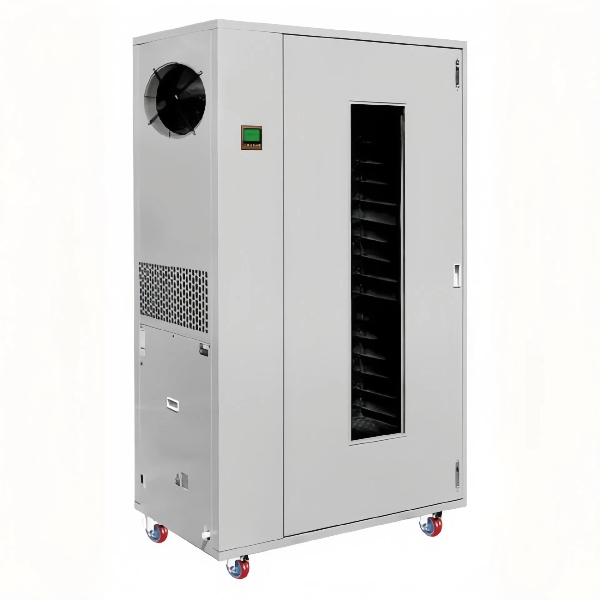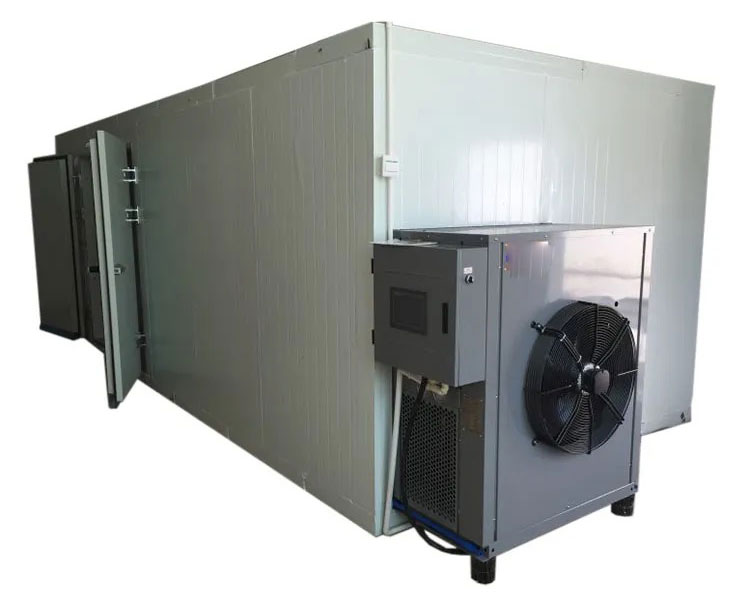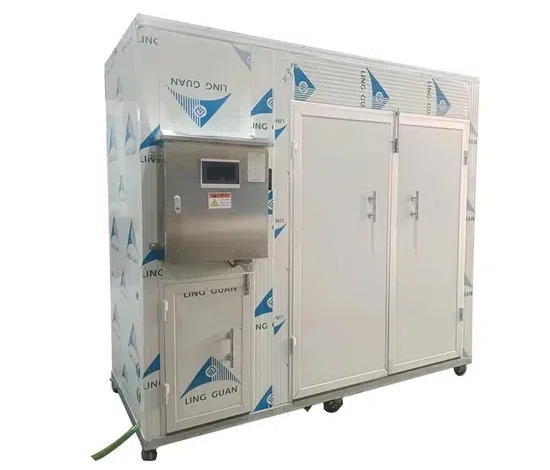
Content Menu
● Key Components and Their Functions
● The Drying Process
● Advantages of Cabinet Type Dehydrators
● Advanced Technologies in Cabinet Dehydrators
● Maintenance
● Applications
● Case Studies
● Conclusion
● FAQ
>> 1. What types of food can be dried in a cabinet dehydrator?
>> 2. How do cabinet dehydrators ensure even drying?
>> 3. Are cabinet dehydrators energy efficient?
>> 4. How often should I clean my cabinet dehydrator?
>> 5. What should be the dehydrating temperature?
● Citations:
Cabinet type dehydrators are engineered for the long-term preservation of food, offering meticulous control over time, temperature, and humidity. They stand as a versatile tool applicable to drying a diverse array of foods, including fruits, vegetables, meats, and herbs. These dehydrators ensure uniform drying, which preserves the quality of the food products through a combination of controlled temperature, humidity, and airflow.
Key Components and Their Functions
Cabinet dehydrators consist of several key components that work in synergy to achieve optimal dehydration. Understanding these components is crucial for optimizing the drying process and ensuring the longevity of the equipment.

-Cabinet: The cabinet includes the side, bottom, top, and back walls along with an air-tight door. It is often insulated to maintain a consistent internal temperature. Insulation materials can vary, but they commonly include foam or double-walled metal construction. The airtight door is crucial for maintaining a stable drying environment, preventing temperature fluctuations, and ensuring consistent drying. Materials used for the cabinet's construction also play a significant role. Stainless steel is a popular choice due to its durability, resistance to corrosion, and ease of cleaning, making it ideal for food processing environments.
-Trays: Trays hold the food items within the cabinet. Trays made of materials such as stainless steel or food-grade plastic are essential. These trays facilitate air circulation around the food, which aids in even drying. The design and spacing of the trays can impact the uniformity of drying, as optimal airflow is necessary to remove moisture efficiently.
-Heating Element: Heating elements, typically made of resistance wire like nichrome, raise the air temperature in the cabinet. The dehydrating temperature should not exceed 145°F (63°C). The placement of the heating element is significant as it is often positioned to allow for even heat distribution throughout the cabinet. The heating element must provide consistent and reliable heat to maintain the desired drying temperature. Some advanced models use multiple heating elements to ensure a more even temperature distribution throughout the cabinet.
-Air Blower: An air blower introduces influent air into the cabinet and maintains suitable humidity within the dehydrating interior. The blower speed control helps maintain humidity well below saturation. Proper air circulation ensures the heated air is circulated evenly around the food, which is critical for consistent drying. The speed of the blower is often adjustable, allowing users to fine-tune the airflow based on the type of food being dehydrated. The blower's efficiency is vital for energy conservation and maintaining the required humidity levels.
-Control System: The control system regulates the temperature, humidity, and airflow within the cabinet. Modern dehydrators often come with digital control panels that allow precise adjustments. Advanced control systems can include programmable settings for different types of food, data logging, and remote monitoring capabilities. These features enhance the dehydrator's usability and ensure consistent results.
The Drying Process
Cabinet dehydrators employ a combination of controlled temperature, humidity, and airflow to remove moisture evenly from food items. The circulating air ensures that all surfaces are dried uniformly, preserving the food's quality. The process can be broken down into several stages:
1. Preparation: Food items are prepared by washing, slicing, and arranging them on the trays. Proper preparation is crucial to ensure even drying.
2. Loading: The trays are loaded into the cabinet, ensuring adequate spacing between the food items.
3. Heating: The heating element raises the air temperature inside the cabinet to the desired level.
4. Air Circulation: The air blower circulates the heated air around the food, facilitating moisture removal.
5. Moisture Removal: As the heated air circulates, it absorbs moisture from the food. The humid air is then exhausted from the cabinet.
6. Monitoring: The control system monitors and adjusts the temperature, humidity, and airflow to maintain optimal drying conditions.
7. Completion: Once the food items reach the desired moisture content, the drying process is complete.
Advantages of Cabinet Type Dehydrators
Cabinet type dehydrators offer numerous advantages, making them a preferred choice for commercial and small-scale operations.
-Precise Control: Cabinet type dehydrators provide precise control over temperature and humidity, ensuring even drying. This is particularly important for delicate items that require specific conditions to maintain their quality.
-Large Capacity: They are designed to handle capacities ranging from 100kg to 1000kg, making them suitable for small-scale operations. This makes them a cost-effective solution for businesses that need to process large quantities of food.
-Energy Efficiency: These dehydrators are designed to minimize energy consumption through insulation and efficient heating systems. Many models also include energy-saving features like automatic shut-off timers and adjustable temperature settings. Energy efficiency not only reduces operating costs but also minimizes environmental impact.
-Versatility: Cabinet dehydrators can dry a wide range of foods, making them a versatile tool for food preservation. This versatility allows businesses to process various products with a single machine.
-Protection from Contaminants: The enclosed design protects food from external contaminants. This ensures that the dried food products are safe and of high quality.
-Portability: Some cabinet type dehydrators are designed for portability and can be directly loaded into shipping containers. This feature is particularly useful for businesses that need to move their equipment frequently.
-Scalability: Cabinet dehydrators offer scalability, allowing businesses to increase their production capacity as needed. Additional units can be added to accommodate growing demand.
Advanced Technologies in Cabinet Dehydrators
Modern cabinet dehydrators incorporate several advanced technologies to improve their efficiency, performance, and usability.
-Digital Control Systems: Digital control systems allow for precise adjustments and monitoring of temperature, humidity, and airflow.
-Programmable Settings: Programmable settings enable users to store and recall specific drying parameters for different types of food.
-Data Logging: Data logging features allow users to track and analyze the drying process, providing valuable insights for optimization.
-Remote Monitoring: Remote monitoring capabilities enable users to monitor and control the dehydrator from a remote location.
-Automated Cleaning Systems: Some advanced models include automated cleaning systems, reducing maintenance requirements.
-Smart Sensors: Smart sensors can detect the moisture content of the food and automatically adjust the drying parameters to ensure optimal results.

Maintenance
Regular maintenance is essential for ensuring the longevity and efficiency of cabinet dehydrators.
-Clean the dehydrator after each use to prevent the buildup of food residue and maintain hygiene.
-Regularly inspect the heating elements and blower for signs of wear or damage.
-Store the dehydrator in a dry place to prevent corrosion and other environmental damage.
-Periodically descale the heating element to remove mineral buildup, which can reduce its efficiency.
-Check and replace air filters regularly to maintain proper airflow.
Applications
Cabinet type dehydrators are versatile and can be used in various industries, including food processing. They are suitable for dehydrating a wide array of products:
-Fruits and Vegetables: Ideal for creating dried fruits, vegetable chips, and other healthy snacks.
-Meats and Fish: Used for making jerky, dried fish, and other preserved meat products.
-Herbs and Spices: Essential for drying herbs and spices, preserving their flavor and aroma.
-Flowers and Leaves: Useful for drying flowers and leaves for decorative or medicinal purposes.
-Noodles and Pasta: Used for drying noodles and pasta, extending their shelf life.
-Pet Treats: Suitable for making homemade pet treats with natural ingredients.
-Tea and Seafood: Can be used to dry tea leaves and seafood products.
Case Studies
-Fruit Processing Plant: A fruit processing plant utilized cabinet dehydrators to produce dried mangoes and pineapples. The precise control over temperature and humidity ensured that the fruits retained their natural flavor and color.
-Meat Processing Facility: A meat processing facility used cabinet dehydrators to produce high-quality beef jerky. The dehydrators' ability to maintain consistent airflow resulted in uniformly dried jerky with an extended shelf life.
-Herb and Spice Company: An herb and spice company employed cabinet dehydrators to dry various herbs and spices. The dehydrators' controlled environment preserved the herbs' and spices' essential oils, resulting in high-quality products.
Conclusion
Cabinet type dehydrators are an efficient solution for food preservation, providing precise control, energy efficiency, and versatility. They are suitable for a wide range of applications, from small-scale operations to commercial food processing. Regular maintenance ensures their longevity and consistent performance. With advancements in technology, modern cabinet dehydrators offer even greater efficiency, control, and usability.

FAQ
1. What types of food can be dried in a cabinet dehydrator?
Cabinet dehydrators can dry a wide range of foods, including fruits, vegetables, meats, herbs, and snack items. You can adjust the temperature and humidity settings based on the specific type of food. This versatility makes them a valuable asset for various food processing needs.
2. How do cabinet dehydrators ensure even drying?
Cabinet type dehydrators use a combination of controlled temperature, humidity, and airflow to ensure that all food items are dried uniformly. The circulating air removes moisture evenly from all surfaces. This uniform drying is crucial for maintaining the quality and consistency of the dried products.
3. Are cabinet dehydrators energy efficient?
Yes, cabinet type dehydrators are designed to minimize energy consumption. They have insulation and efficient heating systems. Look for models with energy-saving features like automatic shut-off timers and adjustable temperature settings. Energy efficiency is not only cost-effective but also environmentally friendly.
4. How often should I clean my cabinet dehydrator?
It is recommended to clean the dehydrator after each use, inspect the heating elements and blower regularly, and store it in a dry place to ensure longevity and efficiency. You should also descale the heating element periodically to remove mineral buildup. Regular cleaning and maintenance will ensure that the dehydrator operates at its optimal performance.
5. What should be the dehydrating temperature?
The dehydrating temperature should not exceed 145°F (63°C). Maintaining the correct temperature is essential for preserving the nutrients and flavor of the food. Different foods may require different temperatures, so it's important to consult guidelines for specific drying times.
Citations:
[1] https://www.dryeratech.com/the-science-behind-cabinet-type-dehydrators.html
[2] https://patents.google.com/patent/CN110207480A/zh
[3] https://www.dryeratech.com/cabinet-type-dehydrator-machine.html
[4] https://patents.google.com/patent/CN201919616U/zh
[5] https://drybox.in/cabinet-type-dehydrator/
[6] https://patents.google.com/patent/CN1110593C/zh
[7] http://www.dryer.comcastbiz.net/dehydrators/cabinet_dryers.html
[8] https://patents.google.com/patent/CN1405396A/zh











